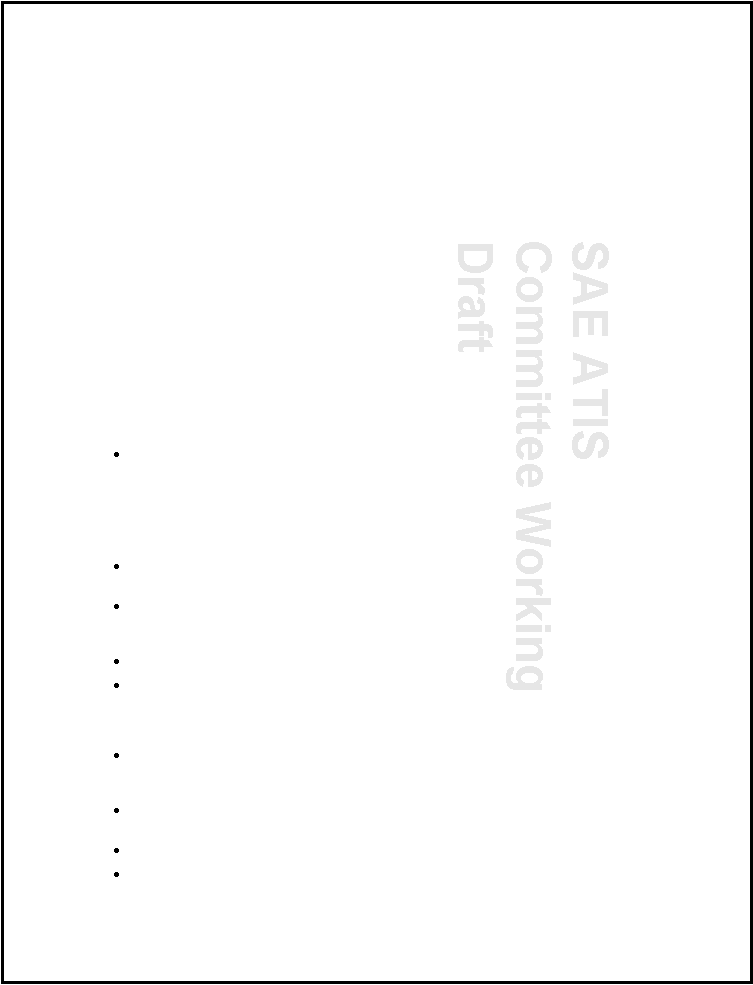
ITIS Phrase Tables, Draft [issued: 04-11-09]
-
217 -
This is a draft document of the SAE ATIS committee, subject to change.
8.
Syntax Rules and Recommendations
The general format for ITIS codes and text allows a sequence composed of a mixture of either a code entry
or a text entry to build up the meaning into an expression. This is at times further restricted to fit into
constraints of size or encoding, but the fundamental pattern remains. This general format can at times
allow multiple valid encoding to be developed by different parties intended to mean the same thing (i.e. No
Parking versus Parking Prohibited versus Parking Not Allowed), and hence produce a potential for
misinterpretation. This is particularly true for signage where multiple independent phrase thoughts are
often combined into one single sign. This section of the standard seeks to avoid this occurrence by
providing additional normative and informative rules for the creation of valid syntax using ITIS codes.
It should also be kept in mind that ITIS phrases are themselves used in an enclosing message which may
contain additional contextual information about how the phrase or sign is applied,. This is where details
such as to which lane(s) a sign should be applied, or for what direction and duration (distance) a sign is to
be used, can occur. Consult the specific standard for details of these cases.
8.1
Syntax Overview
This section of the standard makes use of a simple syntax to show what patterns of ITIS codes are allowed
in certain use cases and expressions. An overview of this syntax and how to read and interpret the rules
and regulations that follow is stated here.
Sequences of allowed ITIS codes are shown as sets of brackets terms, with each term to imply one
or more specific ITIS codes in use, as shown below. Typically the terms inside the brackets will
be given simple names to imply the type of ITIS content or general meaning that that they can
contain.
<Term1>
<Term2>
<Term3>
<Qualifier> <Parking>
<Timeframe> as in: <No> <Parking> <Anytime>
Each item inside a bracket can consist of one or more ITIS terms. Zero terms are also allowed
(typically marked with the term “optional” in the bracketed text).
When qualifier terms are included in such a sequence, the implied meaning of the composite term
is often the opposite of what the basic term may imply (i.e. Tornado Alert vs Tornado Alert
Canceled, Parking Allowed vs No Parking).
Qualifier terms can appear before or after the term or phrase that they apply to.
The name found in bracketed terms are defined further in the sections which follow, and can be
reused in the patterns defined here. For example, the rules dealing with how numerical values can
be expressed (“encoding numbers”) can be reused anywhere a numerical value might be needed in
an expression.
Syntax patterns which are defined in the following vocabulary sections can be used as basic
pattern on which to build compliant ITIS expressions. This list it intended to be illustrative, not
exhaustive, although the rules established herein are normative.
Numbers shown in this section (typically ITIS code values) in brackets are base ten unless
proceeded by “0x” in which case they are base sixteen values.
The letters “n” used to start some phrases should be removed before display to an end user.
ITIS phrases shown in this section in their text enumeration forms are typically expressed in
brackets and follow the precise text and capitalization defined by that phrase.

